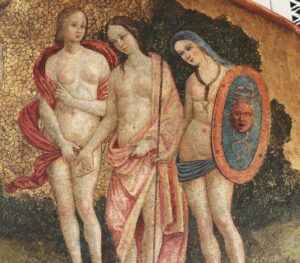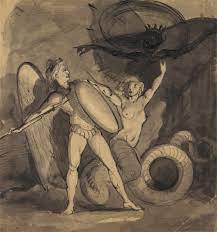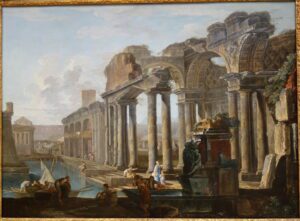Classicism art is a movement that celebrates harmony, restraint, and adherence to established standards of form and craftsmanship.
It’s a portal to the values of ancient Greece and Rome, which have profoundly shaped Western artistic ideals.
We’ll explore the timeless beauty of classicism and its influence on the art that followed.
From the grandeur of marble sculptures to the serene compositions of neoclassical paintings, we’re about to uncover the essence of this revered art form.
Origins Of Classicism
The roots of classicism stretch deep into antiquity, reaching back to the civilizations of Ancient Greece and Rome.
Here, the principles of order, clarity, and balance became staples in the creation of art, architecture, and literature.
These classical ideals held sway as the benchmark of excellence, a template against which all subsequent artistic endeavors were measured.
One could argue that the Renaissance sparked a revival of classical principles through a newfound appreciation for the ancient world.
Artists such as Leonardo da Vinci and Michelangelo drew inspiration from classical forms, blending these time-honored concepts with contemporary techniques to forge a new artistic language.
In the realm of filmmaking, we see the influence of classicism reflected in narratives that emphasize structured storytelling and visual composition.
The balance of elements within each frame echoes the equilibrium sought in classical sculpture and architecture.
Classic films like Metropolis and Citizen Kane showcase the use of symmetry and proportion, harking back to the aesthetic values of classicism.
- Influence of Antiquity – The art and architecture of Ancient Greece and Rome shape classical aesthetics.
- Renaissance Revival – A reengagement with classical ideals emerges in the work of Renaissance masters.
- Visual Storytelling – Classical principles inform the structured narratives and composition in film.
Through a commitment to these enduring principles, classicism retains its relevance in art, reminding us of the timeless standards of beauty and form established millennia ago.
The echoes of classicism are not just found in marble and oil paint but translate across various mediums, including the cinematic screen where every shot can be crafted with the precision and grace of a neoclassical painting.
Characteristics Of Classicism Art
Classicist art is defined by its enduring pursuit of harmony, clarity, and restraint.
The movement prioritizes structured composition, often inspired by the natural world and human form.
These artworks typically showcase:
- A balanced use of space,
- Precise and controlled lines,
- Idealized figures and forms.
Our exploration of classicism art uncovers a steadfast commitment to these principles across various artistic media.
These characteristics serve as a visual language that communicates the values of rationalism and virtue synonymous with classicism.
The color palette in classicist paintings like Oath of the Horatii relies heavily on muted tones, underscoring the gravity and seriousness of the narrative.
In sculptural works such as The Discobolus, attention to physical details and fluidity of motion reflect an adoration for human perfection.
Fascination with antiquity shapes classical forms, as artists jump into the historical world for inspiration.
Unlike the spontaneous and emotive drama of other styles, classicism favors a poised aesthetic.
Simplistic yet powerful storytelling emerges, emphasizing order and proportion.
Notably, in The School of Athens, Raphaël masterfully embodies these traits, constructing an environment where every element complements the other.
In classicism-infused films, visual composition and structured storytelling align to create a cohesive narrative.
Directors may adopt a classical approach in their visual strategy, favoring steady, symmetric shots over kinetic camerawork.
This ensures each frame serves the film’s overarching thematic purpose, much like how every brushstroke contributes to the unity of a classicist painting.
By understanding these features, we grasp how classicism conveys its timeless appeal, drawing on past glories to inform contemporary expression.
Our assimilation of these facets informs our appreciation for not only traditional art but also modern creative endeavors that echo these historic ideals.
Classical Sculpture: The Grandeur Of Marble
When exploring classicism art, one cannot overlook the enduring legacy of marble sculptures.
Originating from ancient times, these masterpieces have stood as testaments to artistic excellence and the pursuit of perfection.
Marble, with its luminous surface and capacity for fine detail, became the preferred medium for classical sculptors who sought to capture the subtleties of the human form and the complexities of emotion.
Marble sculptures of antiquity often depict mythological figures, gods, and heroes in a static poise – a frozen moment of grace.
The attention to anatomy is not merely clinical but infused with a life force that radiates from the stone itself.
Key icons like Venus de Milo and Discobolus showcase:
- The symmetry and harmony in proportions,
- An understanding of human musculature,
- The ability to convey texture, from flowing garments to the softness of skin.
These sculptures served as a bridge between the mortal world and the divine, allowing us to glimpse an idealized version of reality through the eyes of artists like Phidias and Praxiteles.
In our viewings, we’re not just seeing stone carved by hand; we’re witnessing the embodiment of classical philosophy and aesthetics that have shaped our understanding of beauty across centuries.
As filmmakers and visual storytellers, we can’t help but be inspired by the narrative capacity of classicist sculpture.

While the medium differs, the principles of storytelling through rigorous attention to form and detail remain the same.
The thoughtful placement of every frame in a film mirrors the careful chiseling of marble – both aim to create an impactful, timeless experience for their audience.
Through the lens of classicism, we recognize the importance of poise and clarity in our visual compositions.
Whether it’s the stark simplicity of a single shot or the complex layering of scenes, the echoes of classical art carry through to modern storytelling, reminding us that every detail contributes to the larger narrative.
And just as the classical sculptures were polished to eliminate any flaw, we too strive to refine our craft, bringing forth works that resonate with precision and splendor.
Neoclassical Painting: Serene Compositions
In neoclassical painting, artists revived the simplicity and purity of ancient Greek and Roman art.
Neoclassicism became a guiding principle for painters who sought to step away from the ornate styles of the Baroque and Rococo periods.
We see their keen interest in harmony and proportion reflected through serene compositions.
Works like Jacques-Louis David’s The Oath of the Horatii embody the rigorous geometry and moral narratives favored by neoclassical artists.
The use of stoic expressions, muted color palettes, and clear, rational space in these paintings emphasized intellectual clarity over emotional rhetoric.
Here’s how neoclassical painters typically fashioned their canvases:
- Use of chiaroscuro to emphasize solidity and volume,
- Depiction of historical or mythological events with a moral dimension,
- Inclusion of architectural elements to create a sense of order and stability.
By incorporating these traits, neoclassical paintings bridge the grandeur of the past with the intellectual pursuits of their contemporary society.
We observe the clear lines and calm, idealized figures serving as visual morality lessons on canvas, often encouraging virtuous behavior and civic duty.

Our understanding of classicism in art and its impact on various media including film is deepened by studying these serene compositions.
Mastering the visual language of neoclassicism in painting helps us comprehend the narrative techniques that can translate to the big screen, where storytelling and visual poise unite to captivate audiences.
Influence Of Classicism On Western Art
Classicist ideals continue to echo through Western art, establishing a benchmark that many artists have aspired to since antiquity.
Let’s jump into how classicism’s principles have woven their way through art history to inspire an enduring legacy.
In painting, the influence is overt, with figures such as Jacques-Louis David and his contemporaries pioneering the Neoclassical movement.
Their works, like The Oath of the Horatii, reverberated through time, stressing the importance of balance, symmetry, and harmonious proportions that remain prominent in art education and critique.
Sculpture equally showcases the lasting impact of classicism.
Look no further than the revival of classical themes in the Renaissance with works from artists like Donatello and Michelangelo.
Their creations, such as David by Michelangelo, reflect a mastery of form and anatomy that traces directly back to the principles of classicist philosophy.
In architecture, classicism laid foundational norms:
- Emphasis on order and symmetry – Use of columns and domes,
- The Pantheon and Thomas Jefferson’s Monticello stand as testament to classicism’s enduring architectural appeal.
Filmmaking and cinematography, while modern in invention, often lean on classicist aesthetics for visual storytelling.
The framing and staging techniques found in films draw on the structured nature of classicism to convey a sense of grandeur and narrative clarity.
Let’s not forget literature where classics like The Iliad and The Odyssey provide narrative templates that continue to influence story arcs and character archetypes in contemporary writing and screenplays.

Our understanding of these multifaceted influences not only deepens our appreciation for historical artwork but also enhances our interpretation of modern creative expressions that draw on classicist traditions.
What Is Classicism Art – Wrap Up
We’ve journeyed through the timeless elegance of classicism art and its profound impact on various art forms.
Our exploration reveals that the quest for harmony, proportion, and moral storytelling isn’t just a historical footnote but a living tradition that continues to shape our cultural landscape.
Neoclassical paintings, with their serene compositions and intellectual rigor, serve as enduring reminders of the power of art to inspire and instruct.
As we reflect on classicism’s influence, we’re reminded of its vital role in the narrative of Western art and its capacity to inform and enhance our engagement with the arts, both past and present.
Frequently Asked Questions
What Are The Main Characteristics Of Classicism In Art?
Classicism in art is characterized by balanced use of space, precise lines, idealized figures, and a focus on harmony and proportion.
These features are evident in various artistic media including paintings, sculptures, and storytelling in films.
What Is Typical To The Color Palette Of Classicist Paintings?
Classicist paintings often feature a subdued color palette, helping to highlight the importance of form and structure over vividness or emotional expression.
The colors tend to enhance the overall sense of harmony and proportion.
How Does Classicism Influence Storytelling In Films?
Classicism influences film storytelling through structured composition and a cohesive narrative that often mirrors the balanced and idealized nature of classicist art, fostering a clear and rational storytelling approach akin to classical principles.
What Is The Significance Of Neoclassical Painting?
Neoclassical painting revived ancient Greek and Roman ideals of simplicity and purity.
These paintings often depict historical or mythological events and are characterized by their moral dimension, serene compositions, and incorporation of chiaroscuro and architectural elements.
In What Way Does Classical Art Influence Modern Creative Endeavors?
Classical art influences modern creative endeavors by providing a foundation of principles such as balance, proportion, and idealization.
These principles continue to inspire artists today, affecting various forms of Western art, from architecture to literature, shaping our interpretation and appreciation of both historical and contemporary works.


